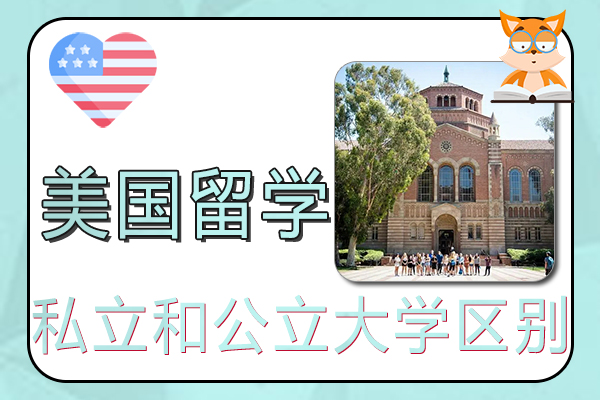Students applying to study in the United States will be concerned about their expenses. Many people worry that the cost of studying in the United States is high.The difference between the cost of studying in private and public universities in the United StatesCost of studying for a master's degree in the United States2023 study abroad expensesHow much does it cost to study in a high school in the United States, ,Cost of studying in the United States for high school studentsThe problem.

The difference between the cost of studying in private and public universities in the United States
1. The difference in cost between studying at private and public universities in the United States
1. The difference between the cost of studying in private and public universities in the United States: miscellaneous fees
For example, the Student Activity Center, the Law Center, the Gym, the Career Center, the Alumni Office, etc. Even if you don't use these resources, you still have to pay for them, so try to use them. From this perspective, taking online classes is actually not cost-effective. Remote online learning, time differences, and inability to effectively utilize school resources. Now that most students can go to the United States to study, this part of the fee is worth it.
2. The difference between the cost of studying in private and public universities in the United States: funding and operation
The main income of private universities comes from alumni donations, tuition, and investment operations of the school fund board. Public universities receive funding from state governments, tuition, and alumni donations. Tuition fees at public universities are divided into in-state tuition fees and out-of-state tuition fees. If a student has permanent residency in the United States or is a U.S. citizen, and his or her family has a record of living and paying taxes in the state for about two years, then he or she can pay very low in-state tuition fees, which are generally around $10,000 a year, and there are also a large number of scholarship and grant opportunities. In addition, if an international student applies for a graduate degree at a public university in the United States and receives a scholarship or grant, he or she may also be eligible to pay in-state tuition fees or be covered by the scholarship. In comparison, private university tuition fees will be more expensive, starting at $35,000. If it is a well-known private university, tuition fees are often around $60,000, plus the need for living expenses and miscellaneous expenses, it will be more than $80,000.
For international students, if they apply to a public university without a scholarship, they will need to pay out-of-state tuition fees, plus international student fees, which is likely to be close to the level of private universities. This means that with the same standardized test scores, UC Berkeley or UCLA may be more inclined to recruit applicants from the mainland rather than Chinese students from California. The reason is simple: the latter pay less and cheaper tuition, while the former have to pay expensive out-of-state tuition. This also explains why there are many articles on the Internet saying that California's affirmative action movement and Asian subdivision movement may affect Chinese admissions, but in fact this has nothing to do with applications from Chinese students. International students take another channel.
In short, the overall tuition level of private universities is still more expensive, because the classes are smaller and there are fewer students for one teacher. So when applying, you can decide based on your personal preferences and family financial situation.
2. Introduction to double degree in the United States
1. What is a double degree?
A double degree means studying two different professional fields at the same time, and you will receive two diplomas upon graduation, such as obtaining a BS and a BA diploma at the same time.
Generally, there are two main types of dual degree programs for Chinese students. One is to obtain degrees in two professional courses during undergraduate or master's studies. The other is to obtain both a bachelor's degree and a master's degree upon graduation.
2. About the duration of the dual degree
Choosing a double degree will not necessarily extend your graduation time, but tuition fees will definitely increase.
If you don't want to extend your graduation time, you need to work harder. Among grades, rest, and socializing, the only thing you can give up is rest. For example, a student at UC Berkeley with a dual degree in economics and statistics graduated in three years.
Time for two undergraduate degrees:
Generally speaking, each university has different graduation requirements for dual degrees. For example, Brown University requires 38 credits for each degree on the basis of general education courses, for a total of 10 semesters; Cornell University's graduation requirement is at least 150 credits, and there are restrictions on degree choices; Stanford University's requirement is 225 credits.
When to graduate with a bachelor's degree and a master's degree:
This dual degree program usually awards a bachelor's degree and a master's degree within 5-6 years. Some schools will issue a bachelor's degree certificate after students meet the undergraduate graduation standards, and then issue a master's degree certificate one year later; some schools require students to complete all undergraduate and master's courses before issuing a degree certificate.
3. Programs that award two graduate/professional degrees
This dual degree awards graduate degrees, which can be two different master's degrees, two different doctoral degrees, or a master's and a doctoral degree. For example, some law schools offer dual degree programs for students to obtain a master's or doctoral degree, or a Juris Doctor JD.
4. About the choice of major for the second degree
The specialization of the second degree can be complementary to or opposite to the original degree.
First of all, employment. If your original major is not easy to find a job, then you can choose a major with easy employment for your double degree. For example, if your original major is philosophy, history, comparative literature, which are difficult to find a job, then your double degree can be in computer science, mathematics, statistics, which are easy to find a job, which will be of great help to your employment.
The second is the complementarity of majors. For example, if your major is education, then you can choose psychology as your double degree. If your major is public administration and sociology, then you can choose a media major to form a good complement.
Finally, the opposite principle applies. For example, if your major is a strong science and engineering major such as computer science, then studying a double degree in business will be of great help to you.
5. Difficulty of obtaining a double degree
Degrees in the United States are based on a credit system. As long as you complete enough credits, you can get the degree certificate.
Because some majors can share some courses with each other, many students who study undergraduate courses in the United States will find it easier to get a double degree, such as a minor in psychology for an education major, or a minor in statistics for a mathematics major.
Of course, if you want to change your direction completely, because there are fewer shared courses, you will have to work harder and spend more on tuition. In addition, you must be prepared to take classes during the summer vacation and have less rest time during the week. Generally, students who can get this kind of double degree are very determined academic masters.
Another option is to complete the master's program directly during your undergraduate studies. Although this option is also very difficult, it is relatively easier than completely changing your major to get a double degree. Therefore, you can also see many returnees who have already obtained a master's degree after completing four years of study.
3. Introduction to the American Study Abroad System
1. Semester system
This is the same as the academic system of domestic universities. Each academic year is divided into two semesters. Each semester has 14-20 weeks of courses. The study time is about nine months. One week will be arranged as an examination week in each semester for everyone to complete the course assessment.
With this arrangement, students will have more time to arrange their own course studies and prepare for exams. They will have sufficient time for both theoretical learning and project research. However, this will also bring the disadvantage of low efficiency and resources will not be fully utilized.
2. Quarter System
One academic year's study is divided into ten semesters. Each semester has about 9-11 weeks of courses, and also includes summer courses. The goals of each quarter will be arranged according to the four seasons, so that everyone's study will be more compact. The summer courses are elective courses, and you can report not to attend classes.
The arrangement shortens the teaching time and increases the number of semesters so that students can remain in a more active and sensitive learning stage. There will also be fewer courses per semester so that students can be more focused. However, due to the tight schedule, everyone faces greater pressure.
3. Three-semester system
This academic system is more common in European countries and has been introduced in the United States. It divides the twelve months of a year into three semesters. Students must complete the fall and winter semesters, and can take the spring and summer classes as electives. There are four admission opportunities each year, and students can apply for graduation after completing their studies.
The first semester is the fall class, which will start in late August or early September and end before Christmas; the second semester is the winter class, which starts in January and ends in October; the third semester will be divided into two small semesters, and you can choose any semester to enroll and take elective courses.
4. 4-1-4 or 4-4-1
As the name suggests, the study time of one academic year is divided into three stages, including two four-month semesters and one one-month semester. Mini semesters can be arranged between semesters or after semesters.
The ten-month semester is the formal period of professional course study. Everyone needs to complete their professional studies in school. The mini semester will arrange students to conduct study exchanges or internships outside the school.
Summary of the difference in cost between studying in private and public universities in the United States
After understanding the difference in fees between studying at private and public universities in the United States, you will also need to prepare an online tool to bypass the firewall and return to China when studying in the United States.For many Chinese who go to the US to study and work, they still like to watch some Chinese TV series and programs in China, and they are more accustomed to use some domestic native apps to listen to music, watch videos, play games and so on. However, due to copyright reasons, most of the popular programs are only allowed to be accessed by mainland IPs. In such a big background, theBack to China via the InternetQuickFox has provided over-the-counter service for more than 10 million devices. After downloading and installing the QuickFox service, overseas users can solve the geographical restrictions with one click, and the connection speed is fast and stable.














